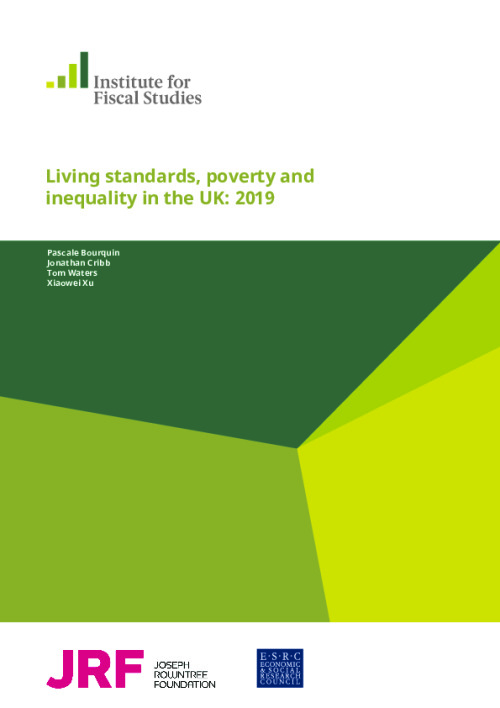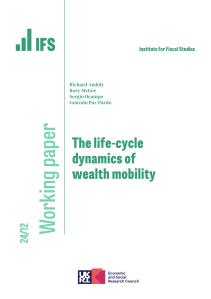This report examines how living standards – most commonly measured by households’ incomes – have changed for different groups in the UK, and the consequences that these changes have for income inequality and for measures of deprivation and poverty. In this latest report, we focus in particular on those people who are poorest in society, with two of our three main chapters focusing on poverty.
Living standards and income inequality - Key findings
Median (middle) household income stalled completely in 2017–18 (the latest data)
This was only the fourth year in the last 30 years in which household incomes have not grown. It leaves median income only 5.6% higher than 10 years earlier in 2007–08, before the Great Recession. Prior to this year, however, the recovery had seen reasonable income growth – median incomes grew at a rate of 1.6% a year from their low point in 2011–12 until 2016–17, which is higher than the pre-recession rate of 1.2% per year seen from 2002–03 to 2007–08.
The key driver for stalling income overall has been employee earnings growth being lower than inflation in 2017–18
Real median employee earnings fell by 0.3% in 2017–18. Although nominal (cash-terms) earnings growth was similar to the previous year, inflation rose from 0.9% to 2.7% as a result of the lower sterling exchange rate following the EU referendum
Reductions in the reported amounts of working-age benefits pushed down incomes of poorer households in 2017–18
This depressed the net incomes of poorer families, while incomes for middle- and high-income families stagnated or slightly grew. The bottom fifth of the income distribution on average saw its income decline by 1.6% in 2017–18; conversely, the top fifth saw it grow by 0.8% and the middle fifth on average saw no movement in income over this period.
However, overall income inequality as measured by the Gini coefficient barely changed in 2017–18
The UK Gini coefficient was 0.34 in 2017–18, the same as it was in the late 1980s. Nonetheless, income inequality is still substantially higher than it was in the 1970s.
Since the recovery from the Great Recession began in 2011–12, the incomes of different age groups have performed similarly
The age group that has seen the strongest growth in incomes since 2011–12 is 22- to 30-year-olds, who did worst during the 2007–08 to 2011–12 period. Pensioners, who did much better than working-age families in the recession, have seen much more similar income growth to working-age households since 2012–13; if anything, their incomes have fallen back in comparison. However, as a whole since 2007–08, pensioner incomes have on average grown substantially more than non-pensioner incomes.
Income poverty - Key findings
Absolute poverty remained virtually unchanged at 19% in 2017–18, using incomes measured after housing costs are deducted (AHC)
This comes after gradual but continuous falls in AHC absolute poverty since 2012–13. Absolute poverty remains at its lowest ever level, 16 percentage points lower than in 1997–98.
Since last year, a new measure of poverty has been proposed by the Social Metrics Commission (SMC)
The SMC measure accounts for costs of childcare and disability, and the amount of savings that households have, among other differences. The trends in the SMC measure are similar to AHC relative poverty, although pensioner poverty is materially lower on the SMC measure than in the official statistics.
Absolute child poverty rose by 1 percentage point in the latest year as working-age benefits and tax credits were reduced in generosity
Rates of material deprivation among children also rose very slightly. However, rates of child material deprivation are considerably – over 5 percentage points – lower than in 2012–13.
The official data show relative pensioner poverty rising since 2011–12, and absolute pensioner poverty stagnating, after decades of almost continuous falls. However, upon closer inspection, this may be due to issues with data quality, particularly in the 2017–18 data
The slowdown in income growth among low-income pensioners, which underlies the reversal in pensioner poverty trends, is fully explained by an apparent decline in private pension incomes. The decline among younger pensioners may reflect the introduction of pension freedoms, which means that pensioners who choose to draw their entire defined contribution pensions as a lump sum are not recorded as having private pensions in the survey data. But this cannot explain all of the decline, as the share of older pensioners with private pension incomes (most of whom will have already annuitised their pension pots) has also fallen since 2014–15.
A number of other developments have affected income growth among low income pensioners since 2011–12, but these approximately offset each other
Pensioners’ housing costs have continued to rise, reflecting a sustained rise in private and social rents. Prior to 2011–12, these rent rises were offset by a shift from social renting to homeownership, but the housing tenure composition among pensioners has changed little since 2011–12. A slowdown in income growth from employment also contributed slightly to lower net income growth. However, these changes were offset by higher incomes from state benefits, as the state pension has been made more generous.
Rates of material deprivation among pensioners have continued to fall, which is consistent with the observed rise in pensioners’ income poverty being a data quality issue
Since 2010–11, the share of pensioners who reported being unable to afford items in the material deprivation index has fallen across most items, with the largest falls in the shares of pensioners who were unable to go out socially at least once a month or take a week-long holiday at least once a year.
Severe poverty - Key findings
Measuring severe poverty is challenging because surveys struggle to capture those with very low living standards – and so we investigate several measures
‘Headline’ relative income poverty is defined as having a household income below 60% of the median. We use three sorts of severe poverty measures: very low household income (below 50% or 40% of median), low household expenditure, and ‘material deprivation’ – defined as not being able to afford basic items (e.g. keeping the home warm or saving £10 each month). These are not measures of ‘destitution’ – such as homelessness or malnutrition – but of having living standards meaningfully below those at the headline poverty line.
Those with the lowest incomes do not always have the lowest living standards
– of those in severe income poverty, only about half are ‘materially deprived’ or in expenditure poverty. Part of the reason for this is that some of those with low incomes are only temporarily on low income (e.g. because they are between jobs) and so can maintain their living standards.
Material deprivation has clearly declined among working-age families since 2010–11
Rates of material deprivation in 2017–18 were a fifth lower than in 2010–11. This decline is seen across all items, including those that seem most indicative of severe poverty (such as keeping the home warm and keeping up with bills). Declines in material deprivation were seen across the income distribution.
Headline income poverty, and income and expenditure measures of severe poverty, all suggest relatively little change since 2010–11
This is in contrast to the falls seen in material deprivation. There is some (tentative) evidence that one reason for the difference may be that the items that material deprivation measures track access to have become cheaper (in real terms). In any case, these results suggest that a growth in severe poverty is not ‘hiding’ behind the little change seen in headline poverty.
In broad terms, the regions and nations of Great Britain that have more headline poverty also have more severe poverty
London has the highest rate of poverty across all poverty measures, and the rest of the South the lowest. However, severe poverty is more concentrated in London than is headline poverty: the headline poverty rate in London is 31% higher than elsewhere in GB, but the rates of more severe forms of income and expenditure poverty and material deprivation are 37–47% higher.
Social renters account for a larger share of those in severe poverty than they do those in headline poverty – but severe poverty is increasingly becoming about private renters
Headline income poverty is roughly equally split between social renters, private renters and owner-occupiers. But among those in the most severe forms of poverty, social renters outnumber private renters at least three to two. However – just as with headline poverty – this pattern is changing: in 2004–05 private renters made up 16– 23% of those in severe poverty (depending on the measure used), but by 2017–18 this share had grown to 26–36%.
Compared with headline poverty, severe poverty is more concentrated among workless households than working households – but again this is a pattern that is changing
Those in working households make up just under 60% of those in headline income poverty, but slightly (2–7 percentage points) less of those in more severe forms of poverty. However, they are accounting for a growing fraction of both: between 2004–05 and 2017–18, the share of those in headline poverty that are in working households grew by 10 percentage points (from 48% to 58%), and for severe poverty it grew by 5–26 percentage points (depending on the measure).













